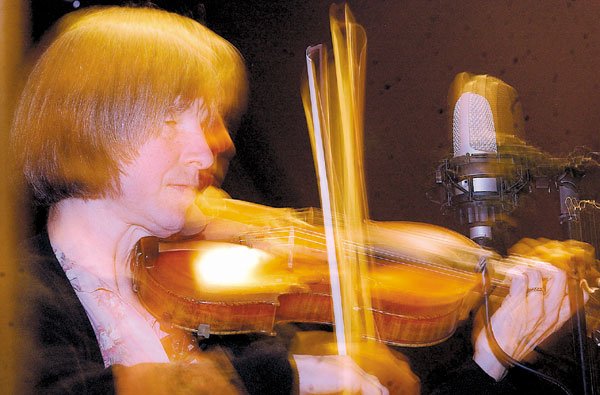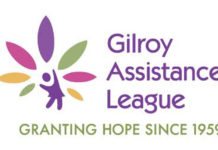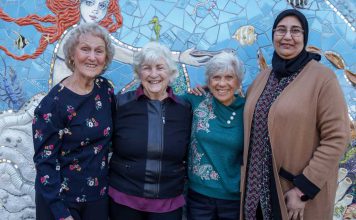Sixty-seven-year-old Mary Campanelli spent her Saturday night
gettin’ down on the dance floor.
Dancing is nothing new for Campanelli, an Aptos resident who
last year frequented a Capitola senior citizens’ center for folk
dancing lessons.
Sixty-seven-year-old Mary Campanelli spent her Saturday night gettin’ down on the dance floor.
Dancing is nothing new for Campanelli, an Aptos resident who last year frequented a Capitola senior citizens’ center for folk dancing lessons. Saturday night, though, turned Campanelli into an entirely new animal, as she gave it her all trying to master the lively, fast-paced footwork of contra dance at the Aromas Grange Hall.
A relative of the square dance, contra dance is an energetic, traditional American form of dancing performed to live music, usually American old-time tunes. The moves are simple and number only about a dozen total, with some almost identical to square dance moves such as do-si-do, swing your partner and promenade.
The socially oriented dance involves a great deal of interaction, hand-holding and locked eye contact – which comes in especially handy during those potentially dizzying swings.
During a contra dance, a caller calls the dance as the music is played, reminding dancers which move comes next. The quick tempo allows dancers just a moment of forgiveness should they miss a step, but regaining focus is as simple as listening to the caller’s instructions.
Saturday’s dance featured Bandemonium!, a two-person contra band with a fiddler and pianist. Calling the dance was Warren Blier, a contra dance enthusiast for 17 years.
“I came across contra dance almost by accident. I was at a folk dance, and someone told me that if I liked this – which I did – I’d like contra dance,” he said. “And as soon as I walked in the room, I loved it. I loved the sounds; I loved the music.”
Even the rhythm-impaired can’t help but tap their toes to the wild, nonstop strains of the fiddle and the spirited, pounding strokes of the piano. From their perch on the stage, the band members appeared inspired – and, at times, amused – by the spinning and swirling dancers below them.
Contra dance has its roots in English country dancing, which was popular in the 17th century. According to one theory, the dance got its name from the French, who claimed they – not the English – invented country dancing.
They converted the phrase “country dance” to contredans, which means “opposites dance” in French, to reflect the opposite stance of couples during the dance. When it later spread to North America, the dance was termed contra dance.
The social engagement and lighthearted atmosphere of contra dance is another reason Blier said he and many of the dancers he observes enjoy the jig. A resident of Monterey, Blier started calling dances about nine years ago and travels the Bay Area to maestro various contra dance events.
Prior to the dances, Blier provides a half-hour lesson for beginners, pairing them with more experienced dancers and patiently teaching the basic moves.
Campanelli, for one, appreciated having a dancer more knowledgeable than herself as a partner.
“It’s nice to be with people who know what they’re doing,” she said with a laugh, her cheeks bright red while taking a breather after her second dance. “It’s so fun, though. Everyone’s so friendly – they don’t care if you don’t know how to dance.”
Chris Flescher, 34, has a little more experience under his belt. The Salinas resident learned to contra dance about six years ago when he was a student at the University of California, San Diego, and although it took him a few months to learn to count the beats and become adept at the moves, Flescher now regularly attends contra dances in Aromas, Monterey and Felton.
“One of the things I like about contra dance is it’s so social. With swing dancing, you’re usually dancing with just one person, but this, you’re dancing with lots of different people,” he said.
Although Flescher said he goes contra dancing simply to have fun and be around other people, it doesn’t hurt that some of those people are potential future dates.
“I hear a lot of people my age say they get sick of going to bars and doing that scene all the time to meet people,” he said. “If people want something new, they should try contra dance. It’s amazing how much fun it is, and I’d say I meet three of four women every time I come.”
Not a bad idea, but for now, Flescher’s date to the dances is his mother, Diane Flescher, 63, who moved to California from Massachusetts seven years ago. Since her first contra dance two years ago, she said she’s made several friends at the dances with whom she also spends time during the week.
“I didn’t know anyone when I came out here, and I work four evenings a week, so it’s hard to get out and meet people,” she said. “Now I know lots of people.”
One of Diane Flescher’s favorite aspects of contra dance is the exercise it provides. At Saturday’s dance, more than two dozen dancers filled the hall, breaking occasionally – but not often – to pat dry their sweating faces, take a few swigs of cold water and rest their aching but happy soles.
Like Diane Flescher, Campanelli said one of the reasons she plans on returning to Aromas for contra dance is for its mental and physical benefits.
“One of the most vital things for people in my age group is to get out there and get some mental stimulation and physical activity,” Campanelli said. “And I can say, this just feels really healthy.”
What is contra dance?
Contra dance is a form of American folk dance performed in sets of couples, which form two parallel lines that span the length of the dance floor. Partners complete a short series of moves with each other and another couple, and when they have completed the series, each couple moves down the line of other couples and repeats the moves with a new couple. As the sequence progresses, couples eventually dance with every other couple in the line.
A full dance lasts eight to nine minutes and is performed to live music, usually the fiddle as lead instrument and the piano as accompaniment. Dancers are not required to wear any particular style of clothing or costume. Lightweight, breathable attire is more comfortable and practical, as are flat, soft-soled shoes. Dancers can attend the dance with a partner or by themselves.
The Aromas Grange Hall holds contra dances from 7:30 to 10:30pm on the second Saturday of each month. A beginners’ lesson starts at 7pm. The hall is located on the corner of Rose Avenue and Bardue Street in Aromas. Admission is $8. For more information, call (831) 372-7528 or go online at www.geocities.com/montereycdc.














